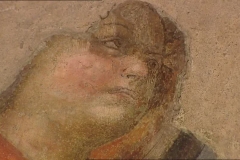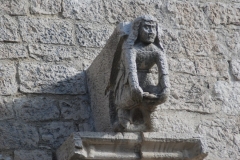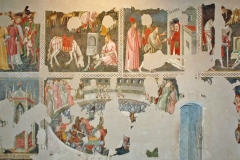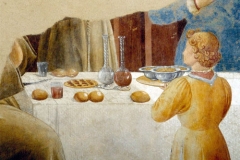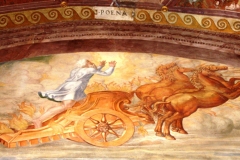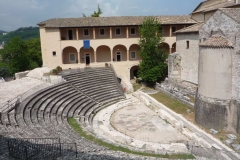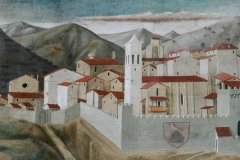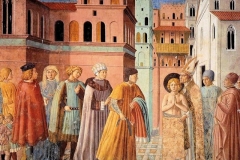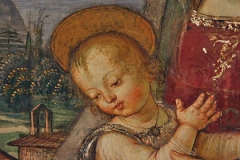Spoleto was a Roman colony – later occupied by the Goths, then taken by the Lombards – was elected the capital of the duchy. In 1324 Spoleto was conquered by Perugia, then passed under the dominion of the Church.
In 1298, an ancient and prestigious Roman Jewish family, the de Pomis, settled in Spoleto. In that year, the Inquisition tortured to death Rabbi Elia de’ Pomis, based on unclear accusations. His family assets were seized and the surviving members of his family sought refuge elsewhere, settling mostly in the Umbrian city.
The first surviving document on the Jewish presence within the city dates back to 1342 and reports of a license granted by the General Council of Spoleto to Manuele and Elias de Urbe.
Between the 13th and the 16th century, the main Jewish families in Spoleto practiced moneylending. Records also indicate that some Jewish families managed horse rental for out of town transportation; textile and cord manufacturing; cattle sale as well as oil making. One or two licenses for rag sales were given to Jews and, a rare case for the time, we find that a local Jews traded in construction materials (selling 2,000 bricks to the City to pave a square).
Documents indicate that there may have been a synagogue in the early part of the 15th century, but its location remains unknown.
A 1516 document shows that there was a synagogue in the house of the heirs of Isacco Bonaiuto in Vaita Petrenga. From a 1503 document, it appears that there was a road called the Strata delli judei located near the market Square, in Vaita Petrenga, where many Jews lived and where there were Jewish butchers.
In 1552, the Priori decided to appoint two representatives to raise funds for various improvements that the City hoped to undertake, including repairs within the Jewish area. In the same year, the Priors appointed a commission of four citizens to issue a city plan that restricted Jewish dwelling to certain areas.
In 1539 and in 1543, the issue of restricting Jewish residence was raised again. The City did not want them to live in the center of town. In the end, the proposal to set up a ghetto never materialized.
The Jewish cemetery was located in a place called Valiant, but in 1500 the location of the Jewish cemetery was outside S. Peter Gate.
Leading figures in the Spoleto community were David de Pomis and some members of the Alatino family. David de Pomis (1525-1593) was a doctor who practiced linguistics and philosophy. Born in Spoleto, he was educated in Todi by his uncles Vitale (Yehyel Rehabya) and Moses Alatino.
After studying philosophy and medicine in Perugia, and receiving the title of doctors in 1551, he resided in a series of cities. This included Venice, where most of his works were published.
De Pomis is known for his trilanguage dictionary Tzemah David (Hebrew, Latin, Italian), which also discussed scientific and historical themes. In the preface to the dictionary, de Pomis recounts his genealogy and his life.
Another one of his works De medico hebraeo enarratio apologetica (Venezia, 1588), contrasted the accusations against the Jews and, in particular, against Jewish doctors.
At beginning of the 16th century, another scholar lived in Spoleto. Vitale (Yehyel Rehabya) Alatino, who also had a lending bank, was a renowned physician, who had in his care Julius III, as well as the medicine teacher from Perugia, Bartolomeo Eustachio. After the decree of expulsion from the papal territory, Vitale went to Ferrara. Vitale’s brother, Mosè Amram Alatino (1529-1605) was also a doctor in Spoleto, and after the expulsion, settled in Ferrara and then in Venice.
Mosè Amram translated into Latin the Hebrew version of Themistius’s paraphrase of Aristotle’s De coelo produced by the Jewish translator and scholar Zeraḥyah ben Isaac ben Shealtiel ḥen (Venice, 1574). He also translated into Latin Galen’s commentary to Hippocrates’, De aere, aquis et locis. His source was the Hebrew version by Shlomoh ben Natan ha-Meati (published anonymously in Paris in 1679).
According to David de Pomis, Mosè Amram also translated into Latin the first part of Avicenna’s “canon,” but no documentation of this translation remains.
The first member of the Alatino family was the father, Petahya Jarè ben Barukh, author of halakhic responsa, who lived in Spoleto, Rome and Recanati.
From the Notary Archives
In the 1360s, the city hired Vitale Solomon as a doctor on a monthly salary. The position was renewed, on the same terms, in 1393, in 1395 and again in 1397.
In 1393, the City Council granted the license for moneylending to Aleuccio Solomon de Urbe, a resident of Narni, authorizing him to open one or more banks in Spoleto. The lender, his family and his entourage received permission to live in the city under the same conditions of all other citizens. Aleuccio was not obligated to operate the bank on Saturday or on Jewish holidays and had the right to freedom of worship.
In order to promote conversions, the City granted subsidies to neophytes. In the first half of the 14th century, several conversions are documented in public registries. In 1362, Cecca, daughter of Musetto and a Jew of Spoleto, converted and became a nun. The City Council awarded her an annual stipend. In 1394, it was the turn of a son of Vitale, who assumed the name Battista and received support. A little later, a granddaughter of Vitale, Morbidella, decided to become Christian and obtained money for a dowry, allowing her to marry a Christian man.
In 1399, Guglielmo and Solomone, sons of Abramo da Foligno, and their nephew, Guglielmo di Abramo, were granted a banking license which granted their families and their entourage permission to settle in Spoleto, under the same conditions established in 1393 for Aleuccio, son of Solomone.
In 1416, burdened with the expenses for the funeral of Marino Tomacelli, rector of the Dutchy of Spoleto and a relative of the Pope, the General Council imposed a forced loan on Elia, son of Angelo, and Angelo, son of Elia, for a period of six months, without interest. On the other hand, for the six months in question, the two had permission to increase the interest on general loans up to 30-42%.
In 1443, a request to conduct moneylending, according to the terms agreed with Ventura son of Sabato in 1441, was presented by a group of Jews led by Isacco Lazzaro. Among them was Matassia, son of Solomone, who was also a doctor and surgeon. Matassia, who wished to settle in Spoleto with others, had joined the request due to the fact that the medical profession alone did not grant him sufficient income. The City Council decided to accept the application.
In 1451, following the Lent preaching of Cherubino of Spoleto, the Priors adopted some “Riformanze” regarding the Jews. The practice of ritual slaughter at home was prohibited and Jews could not sell of give meat to Christians. Jews were also forced to wear a badge.
In 1457, the physician Magister Leone was imprisoned in the Fortress of Spoleto for unknown reasons. The governor of the Duchy of Spoleto was a nephew of the Pope and Captain General of the Church. Pope Callisto III informed that he had assigned the Jewish doctor to the Venetian nobleman Giovanni Torcello, allowing his representatives to confer freely with the prisoner. New provisions would be followed and, in the meantime, Magister Leone had to be closely guarded. After about a month, Giovanni Torcello’s son, Manuel arrived in Spoleto with a letter from the Pope that stated: “hand in the doctor to whomever presents this papal document, and allow them to transfer the prisoner out of Spoleto to any the destination he chooses”. From the records, it appears that Leone’s transfer was part of a prisoners’ exchange. Torcello expected that Leone’s release would serve as ransom for his sons, who were held captive in Turkey.
The will of Angelo figlio di Guglielmo da Camerino, a resident of Spoleto, contains an inventory of his property and indicates that he owned a rich collection of Jewish books and parchments.
A bank of the Camerino must have existed in Spoleto at least since 1454.
In the second half of the 15th century, the Jews of Spoleto appear engaged in real estate. In 1472, Raffaello son of Isacco was fined for offending the Priori and a few years later a young man, identified as the son of Mosè, was tried on charges of having had an affair with a married Christian woman.
In 1490, the same Franciscan, Andrea da Faenza, whose preaching had caused the prohibition of ritual slaughter, proposed to the City Council to merge the Monte Frumentario with the Monte di Pietà. The Council accepted, allegedly motivated by the intention to close down Jewish moneylending in the city.
In 1493, the prosecutor of the City went to the governor of Spoleto, in the presence of local Jews, and asked him to issue measures to segregate Jews from Christians, in accordance with the provisions of canon law. Nevertheless, the Municipality had failed to take any action on this request by 1496, beyond allowing the ongoing intimidation of Jews and the continued practice of receiving loans from Jewish bankers.
A stream of conversions continued throughout the 15th century.
Over the course of a few days in 1496, the nuns of the San Matteo convent held a five-year old child, Chiara Stella, claiming she had expressed interest in becoming Christian. The girl’s parents, Abraham and Gentile, appealed to the bishop of Spoleto to get their daughter back. The bishop entrusted the girl to a local Christian woman, waiting for the religious authorities to ascertain her intentions. After several discussions, Alexander VI was called on to intervene and decided that the girl be returned to her parents.
During the first three decades of the 16th century, the city had to resort to Jewish loans.
In 1519, Servadio, son of Raffaele, Consolo, son of Ventura, and Isacco, son of Buonaiuto, appealed to the General Council of the city to be protected from the population excesses during Easter. They complained about the traditional stone-throwing and threatened to leave if the authorities did not protected them. The General Council decided, therefore, to only allow children under 15 could take part in the stone-throwing against the Jews.
In 1539, the Priori of Spoleto appointed a committee of 12 citizens to choose the place where the Jews should be segregated.
In 1539, the City Council re-confirmed the authorization to Jews for engaging lending to the poor. They would have to pay 100 crowns and an annual fee of 10 crowns, to be delivered at the time of the feast of St. Mary in August. Magister Alatino Vitale, who had received the privilege directly from the Apostolic Chamber, would be exempted from paying the fee, but would have to pay 100 crowns to the City within twenty days, for the purchase of wheat, under penalty of the non-ratification of the privilege itself.
In 1540, the City of Spoleto asked Magister Vitale Alatino di Foligno for a 200 ducats loan to finance the expedition of Pier Luigi Farnese to crush an uprising in Perugia.
Following the excommunication of Spoleto (1543), due to lack of observance of religious practices, the City decided to restore the requirement of the badge.
In 1548, the City Council asked the local Jews for a loan to cover the costs for the construction of a fountain near the St. Peter gate. In 1548, they asked Magister Vitale Alatino for a substantial loan to buy grain for citizen needs. If Vitale refused, he would be forced to leave Spoleto within 15 days and his properties would be confiscated. Again in 1551, the City asked for a large loan from Magister Leone Vitale from L’Aquila. In order for the loan to go through, they would have to cancel the ban on Jewish lending that had been imposed earlier. However, the City did not deem it advantageous to make an exception for Leone alone, and the Council decided to remove the ban altogether. The loan made by Magister Leone was guaranteed by four citizens and, shortly after, Magister Leone had to agree to a further loan for the purchase of wheat.
In 1551, with the permission of the papal representative, Cardinal Giulio della Rovere of Urbino, the University of Perugia conferred the title of Doctor in Medicine to David Isaac de Pomis of Spoleto.
In 1553, the City Council forced the bankers to keep their accounting books in Italian or Latin, and not in Hebrew. A new wave of forced alone followed this measure.
In the same year, Smeralda Alatino and her husband, Benedetto son of Mosè, delivered 14 Hebrew books to the vicar general of the bishop of Spoleto to be corrected by the ecclesiastical censor. They paid a fee for this service.
Conversions continued into the sixteenth century. Ten have been recorded and are almost always accompanied by the promise of financial aid.
Jewish presence in Spoleto came to a halt with the expulsion of the Jews from the Papal States, ordered by Pope Pius V in 1569.
In 1585, however, Ventura, son of Semmo, and Salvatore, son of Daniele, asked the authorities of Spoleto for permission to return and settle in the city with a group of coreligionists.
When Pope Sixtus V granted the Jews the right to return and live in the Papal States, the General Council unanimously approved the request and, two years later, Cardinal Enrico Caetani, the papal chamberlain, granted another five Jews permission to reside in Spoleto.
Source: Jewish Virtual Library


